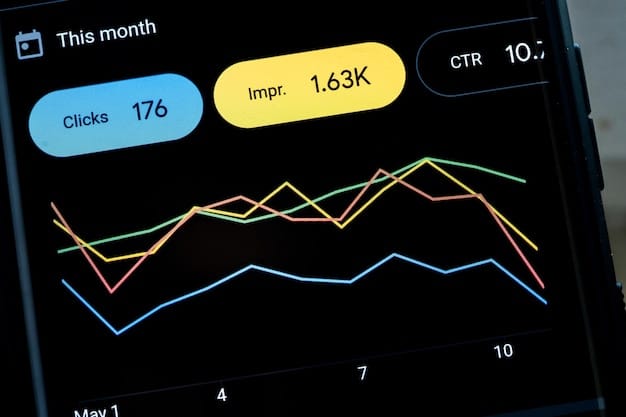Detecting Insider Threats: A 5-Step Guide for US Organizations

Detecting insider threats in US organizations involves implementing User Behavior Analytics (UBA) through a 5-step process that includes identifying critical assets, establishing baseline behaviors, deploying UBA tools, monitoring and analyzing alerts, and continuously refining the system.
In today’s digital landscape, safeguarding your organization from external cyber threats is paramount. However, the risk posed by insiders—employees, contractors, or partners with access to sensitive data—can be just as devastating. Detecting insider threats: A 5-step guide to implementing user behavior analytics in your US organization offers a proactive strategy to mitigate these risks. Recognizing unusual activity is crucial, and this guide will equip you with the knowledge to enhance your security posture.
Why Insider Threat Detection Matters for US Organizations
Insider threats are a serious concern for organizations across the United States. Unlike external attacks, insider threats exploit authorized access to systems and data, making them harder to detect. Neglecting this aspect of cybersecurity can lead to significant financial losses, reputational damage, and legal repercussions.
A robust insider threat detection program is not just a security measure; it’s a business imperative. By implementing proactive strategies, US organizations can significantly reduce their risk exposure and protect their valuable assets.
The Cost of Ignoring Insider Threats
The financial impact of insider threats can be staggering. Ponemon Institute’s 2020 Cost of Insider Threats Global Report found that the average cost of an insider threat incident is over $11 million. This includes direct costs like investigation, remediation, and legal fees, as well as indirect costs like lost productivity and damage to brand reputation.
- Financial Loss: Data breaches, intellectual property theft, and fraud can lead to significant financial losses.
- Reputational Damage: A compromised reputation can erode customer trust and impact business opportunities.
- Legal and Regulatory Issues: Failure to comply with data protection regulations can result in hefty fines and legal action.
Protecting your organization from insider threats is essential for maintaining financial stability, preserving brand reputation, and ensuring compliance with legal and regulatory requirements. User behavior analytics provides a powerful tool to see unusual digital behavior, flagging activity that needs further investigation before it can cause damage.

Step 1: Identify and Prioritize Critical Assets
The first step in implementing an effective insider threat detection program is to identify and prioritize the assets that are most critical to your organization. This involves a thorough assessment of your systems, data, and intellectual property to determine what needs the highest level of protection.
Not all assets are created equal. Understanding which assets are most valuable and vulnerable will help you focus your detection efforts where they are needed most. Start by listing the assets and then rank them.
Categories of Critical Assets
Critical assets can fall into various categories, each requiring specific security measures:
- Sensitive Data: Customer data, financial records, and employee information.
- Intellectual Property: Trade secrets, patents, and proprietary designs.
- Critical Systems: Databases, servers, and network infrastructure.
By understanding the types of assets your organization relies on, you can tailor your insider threat detection program to effectively safeguard what matters most. Consider the cost of a compromise for each asset, evaluating your risk assessment.
Step 2: Establish Baseline User Behavior
Once you have identified your critical assets, the next step is to establish a baseline of normal user behavior. This involves understanding how users typically interact with systems and data so that you can identify deviations that may indicate malicious activity.
Establishing a reliable baseline requires collecting and analyzing data over a period of time to identify patterns and trends, looking for deviations that matter.
Techniques for Establishing Baselines
There are several techniques you can use to establish baseline user behavior:
- Access Patterns: Track which resources users access, when they access them, and how frequently.
- Data Usage: Monitor the amount of data users download, upload, and transfer.
- Login Activity: Analyze login times, locations, and methods.
Accurate baselines allow you to distinguish between normal activity and potentially malicious behavior, improving the effectiveness of your insider threat detection program. If someone starts logging in at 3am every day to download all the sales data, for example, that could be something to check, based on this step.
Step 3: Deploy User Behavior Analytics (UBA) Tools
User Behavior Analytics (UBA) tools are essential for automating the detection of insider threats. These tools use machine learning and advanced analytics to analyze user activity and identify anomalies that may indicate malicious behavior.
UBA tools can ingest and process large volumes of data from various sources, providing real-time insights into user behavior across your organization. These tools automatically monitor and flag any deviations from baseline behavior.
Key Features of UBA Tools
When selecting a UBA tool, consider the following key features:
- Anomaly Detection: Identify unusual patterns of behavior that deviate from established baselines.
- Risk Scoring: Assign a risk score to each user based on their behavior and the potential impact of their actions.
- Reporting and Visualization: Provide clear and concise reports and visualizations to help security teams understand and respond to threats.
With the right UBA tool, you can automate the detection process and quickly identify potential insider threats before they cause significant damage. Select tools based on your organization’s size, complexity, and security requirements, and include a period for training and integration.

Step 4: Monitor and Analyze Alerts
Once you have deployed a UBA tool, it is crucial to continuously monitor and analyze the alerts it generates. This involves establishing a dedicated security team to review alerts, investigate potential threats, and take appropriate action.
Alert fatigue can be a significant challenge when using UBA tools. Prioritizing alerts based on risk score and potential impact is crucial for efficient incident response. Look at patterns over time, not just at one-off triggers.
Effective Alert Monitoring Strategies
To effectively monitor and analyze alerts, consider the following strategies:
- Establish Clear Response Procedures: Define clear procedures for investigating and responding to alerts.
- Prioritize Alerts: Focus on high-risk alerts that pose the greatest threat to your organization.
- Document Investigations: Maintain detailed records of all investigations, including findings and actions taken.
By following these strategies, you can ensure that potential insider threats are identified and addressed quickly and effectively. Create a formal process and train the team who will be responsible for using it.
Step 5: Continuously Refine Your System
Insider threat detection is an ongoing process that requires continuous refinement and improvement. This involves regularly reviewing your program, updating your baselines, and adjusting your security measures to stay ahead of evolving threats.
Regularly assess the effectiveness of your insider threat detection program and identify areas for improvement. Feedback loops will help you stay ahead of the issues. Update your security policies and procedures as needed to reflect changes in your organization and threat landscape.
Best Practices for Continuous Refinement
To continuously refine your insider threat detection program, consider the following best practices:
- Regularly Review and Update Baselines: Ensure that baselines reflect current user behavior and system configurations.
- Incorporate Feedback: Gather feedback from security teams, IT staff, and business stakeholders to identify areas for improvement.
- Stay Informed: Keep up-to-date with the latest insider threat trends and detection techniques.
Continuous refinement ensures that your insider threat detection program remains effective and adaptable in the face of new and evolving risks. Remember to balance security with user privacy, and ensure compliance with all relevant data protection regulations.
| Key Point | Brief Description |
|---|---|
| 🎯 Identify Critical Assets | Determine and rank the organization’s most valuable assets to protect first. |
| 📊 Establish User Behavior Baseline | Track normal user activities to identify deviations indicating threats. |
| 🛡️ Deploy UBA Tools | Use machine learning tools to automate insider threat detection. |
| 🚨 Monitor and Analyze Alerts | Continuously review and investigate potential insider threats flagged by UBA tools. |
Frequently Asked Questions
▼
Insider threats are security risks originating from within an organization, typically from employees, contractors, or partners with legitimate access to systems and data. Their actions can be malicious or unintentional.
▼
UBA uses analytics to establish baseline behaviors, enabling the detection of anomalies that could indicate insider threats. UBA tools automate and improve threat detection accuracy.
▼
Consider your organization’s size, complexity, and security requirements. Key features like anomaly detection, risk scoring, and reporting are all vital to compare when choosing a tool for your use.
▼
The security team is crucial for monitoring alerts, investigating threats, and taking action. They refine the system based on new data or changes and develop clear response procedures for identified threats.
▼
Continuous refinement is essential. Regularly update baselines, incorporate feedback, and stay informed about new threats. This ensures the system remains effective, and is adaptable to current risks.
Conclusion
By following this five-step guide, US organizations can proactively detect insider threats and protect their critical assets using user behavior analytics. Implementing a robust program is a critical investment in organizational security and resilience. Continuously refine your strategy and stay ahead of evolving threats to maintain a robust security posture.





